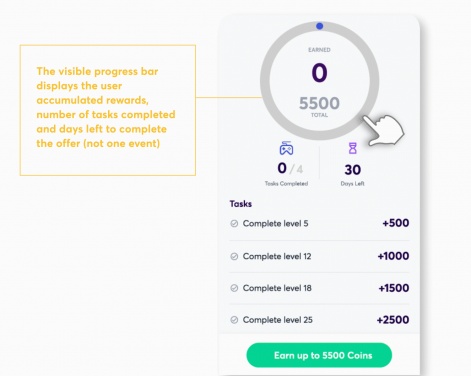Rona Einat is the Product Manager for User Acquisition at Fyber, a Digital Turbine company.
The desire to make ad monetisation a seamless part of the game experience is a constant race. Striking a balance between content, ads and virtual currency in a way that enhances the user experience can be even tougher.
One of the best ways to find this point of equilibrium is through user-initiated formats.
Publishers are constantly exploring new ways to optimise their ad monetisation, especially in the wake of the privacy changes that have impacted eCPM and overall performance.
Rewarded Video has long been a popular go-to, however, the ‘Offer Wall’ is gaining momentum as an ad format that enhances the user experience, drives a complementary boost to a publisher’s ad revenue, and enables advertisers to diversify their user acquisition strategy.
A user-first mindset pays off
The Offer Wall works best for games that have a sophisticated game economy and focus on long-term retention.
By designing key moments throughout the game where virtual currency can improve players’ chances of success, developers create a clear incentive and explicit reliance on accumulating virtual currency.
What makes the Offer Wall unique is its flexibility and customisability.
Different segments of users at different points in the user journey are likely to have very different virtual currency needs. The Offer Wall enables players to choose from a variety of offer types that match their engagement preferences as well as their virtual currency needs.
What makes the Offer Wall unique is its flexibility and customizability.
Rona Einat
Users can either complete ‘quick and easy’ tasks for a small payment or ‘long and difficult’ tasks for a more substantial reward.
The rewards get better
The Multi-Reward Cost Per Engagement (CPE) offer type is the most recent offer type to be introduced to the Offer Wall, and it has been very well received by publishers, advertisers, and users alike.
Single-action CPE offers enable advertisers to choose a specific post-install action (typically one that is a strong predictor of positive ROAS) as the event that triggers a conversion.

Multi-Reward offers take the same concept to the next level by allowing advertisers to break down the offer into multiple post-install actions (ranging from easy to hard) for which the user collects incremental rewards – until reaching the ultimate reward.
More ways to make progress
With the addition of Multi-Reward offers, users gain better control over the time they would need to invest in order to receive the reward they are seeking.
User satisfaction on Multi-Reward offers is high because they get rewarded even by partial completion of these offers, rather than being frustrated by failing to reach a difficult level and investing time and effort that don’t yield a reward.
The first milestone of Multi-Reward offers is typically relatively quick and easy to complete, making more offers relevant to a wider audience.
Gain control over ROAS
For user acquisition advertisers, Multi-Reward offers enhance the First Time User Experience (FTUE), by adding an extra layer of incentive to the user’s first game session. Advertisers have complete control over which post-install events would trigger partial rewards.
This means that advertisers can choose events that ensure that players get exposed to content or features that improve the likelihood of users becoming loyal long-term players or making in-app purchases.
When Lilith Games started running Multi-Reward offers, they saw an uptick of 250% in Install Rate and D7 ROAS improved by 72% compared to ‘regular’ single-action offers.
This new setup ensures that publishers see the money sooner and therefore boost their revenue quicker.
Rona Einat
Users who were acquired through Multi-Reward offers also had 56% better Retention Rate, as the majority of users were seeing the offer to its full completion, engaging with deep post-install events.
More conversions = get paid more
The beauty behind the Multi-Reward offers is that for every post-install event that triggers a reward, the publisher generates incremental revenue, even when users don’t entirely complete an offer.
This new setup ensures that publishers see the money sooner and therefore boost their revenue quicker.
Since we implemented Multi-Reward, user engagement increased and audience reach for advertisers grew, which led them to grow their investment in the Offer Wall.
As we know, higher ad spend leads to higher ARPDAU for publishers. We saw ARPDAU increase by 13% and ARPDEU (i.e. average revenue generated only from users who engage with the Offer Wall) rose by 22% on average.
A well-balanced ad experience
Multi-Rewards offers redefine the connection between game content, ad monetisation, and user experience. It increases earning opportunities for users (with virtual currency) and publishers (through ad revenue) and gives unprecedented control to advertisers over the post-install user journey.
The careful way in which the Offer Wall considers the interests of all parts of the mobile ecosystem has made more publishers take interest in adding the Offer Wall as a core component of their ad monetisation strategy.

